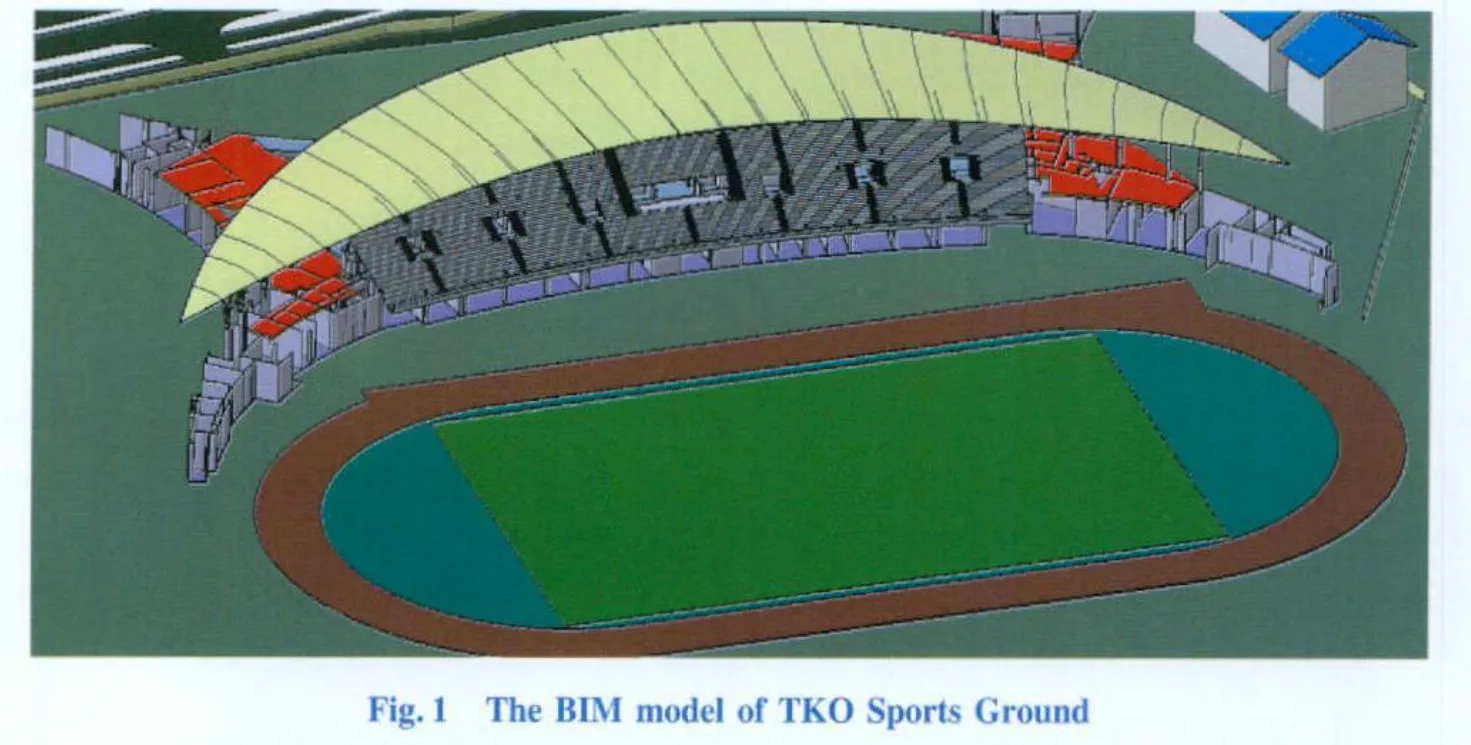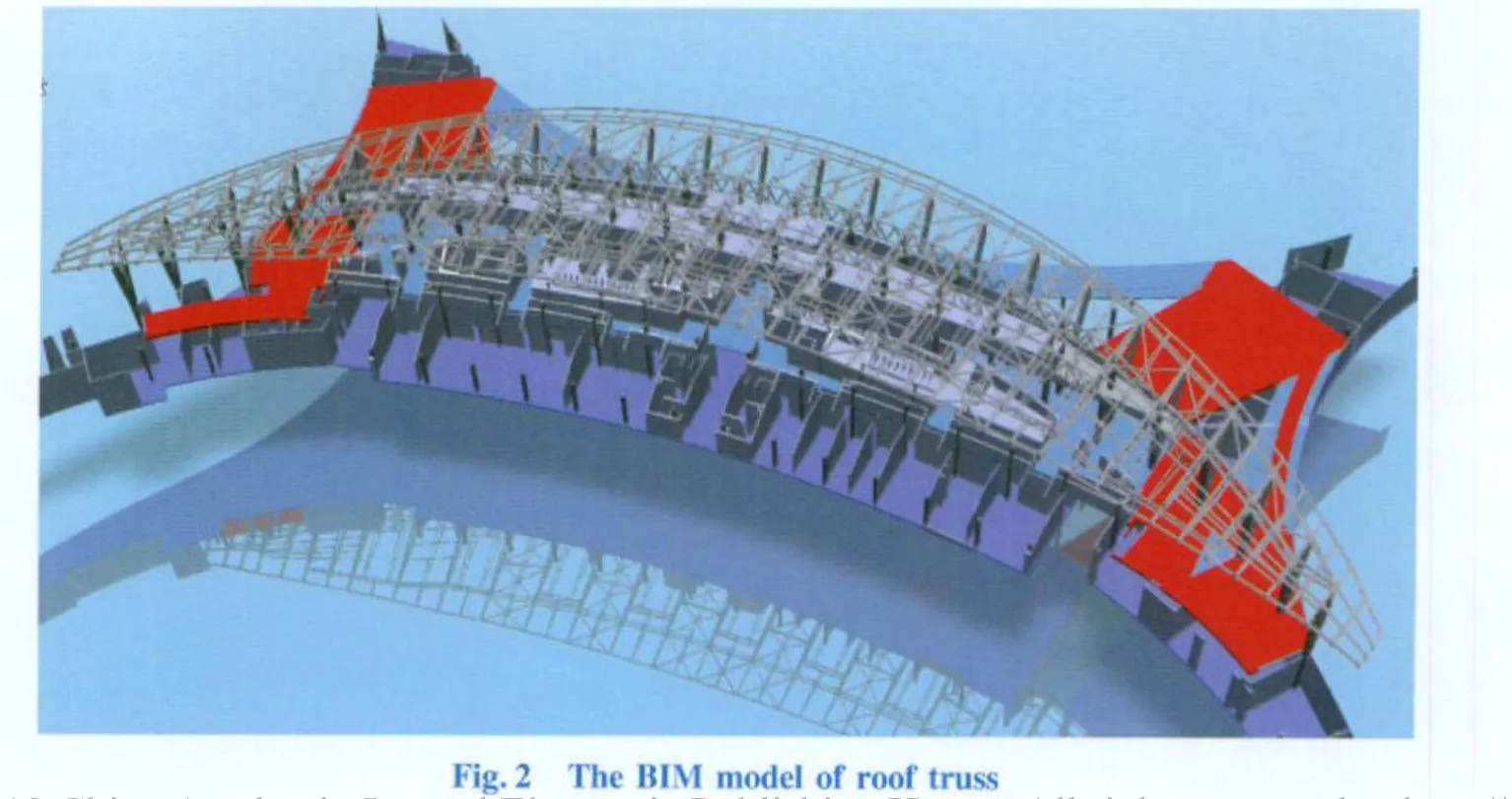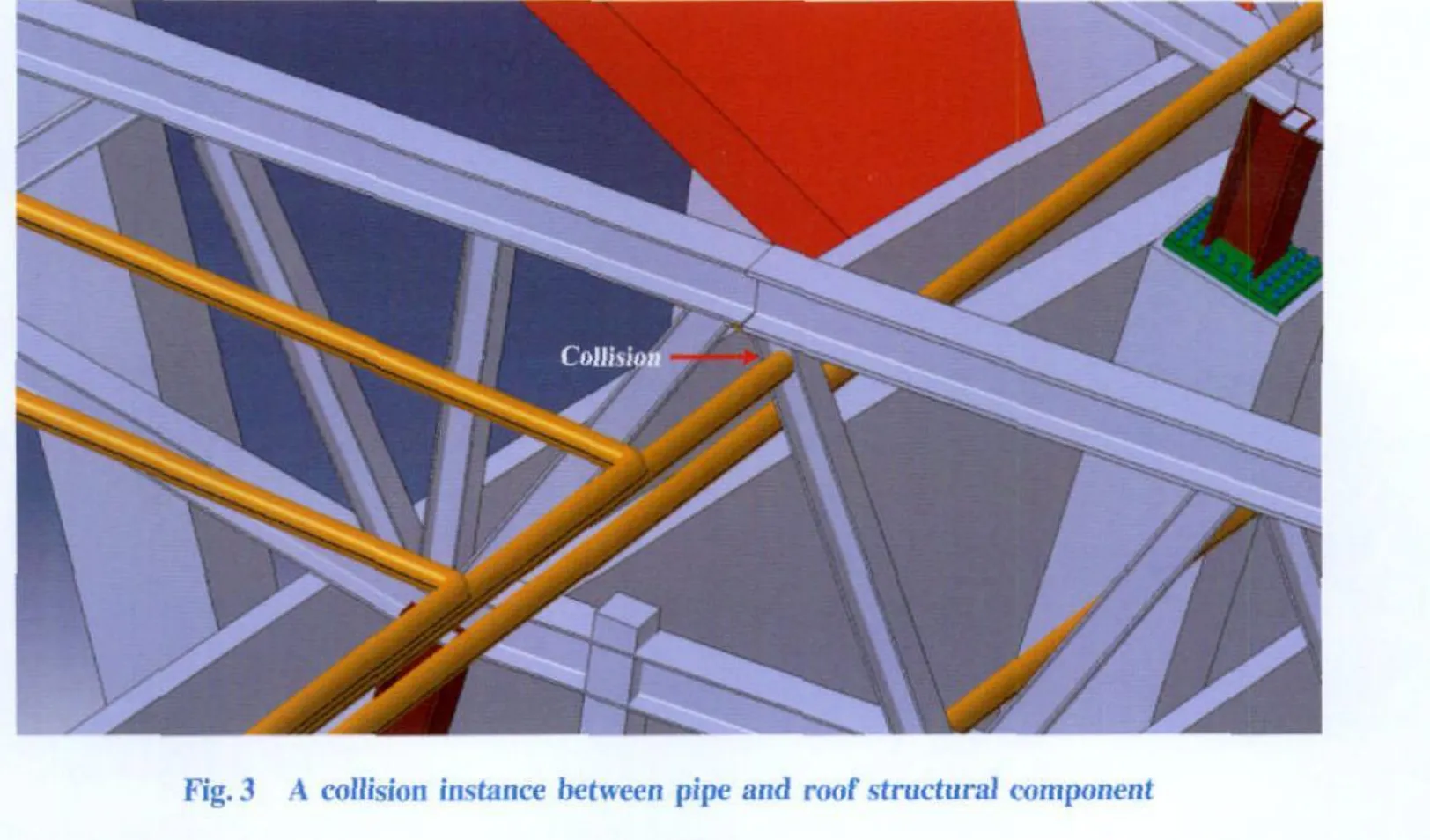Opportunities and Challenges of BIM Implementation:Current Practice in Hong Kong
Fan Hongqin,Guo Hongling,Jin Zhigang,Li Heng
(Department of Building and Real Estate,The Hong Kong Polytechnic University)
Introduction
Building Information Modeling(BIM)is the process of generating and managing a building in for mationmodel through the use of three-dimensional,intelligent design information(AGC America,2010).Implementation of BIM among building industry practitioners will undoubtedly help to improve communication and collaboration during the different stages of the building lifecycle:from planning,design,construction,to the operations and maintenance.In an ideal scenario,a project can be started and completed with all the information added to its Building Information Modelwithout producing any printed 2D drawings:startwith a 3Dmodel of the building,all the information at later stages such as design changes,construction records,commissioning,operations history,can all be added to the samemodel to have an integrated single version of truth on the project.
Although the participants in the building industry of Hong Kong realize the potential benefits to be broughtby the application of BIM,the overall levelof implementation is relatively low.Architectsare early adopters of BIM as they see the obvious advantages of visualized 3D design and easier communication of their designwith clients,BIM is now very popular among large architecture firms.Consultants specializing in BIM servicesare also a popular business in the localmarket.Other than the architects and BIM consultants,preliminary and some limited implementations of BIM have been observed in government organizations(e.g.Hong Kong Housing Authority and Housing Department),structuralengineer consultants,and contractors.Overallboth the govern mentand industry practitioners are feeling the pressure brought by the evolving BIM technology;it is believed that earlier adopters will gain competitive edge in the market.
The Hong Kong Institute of Architects(HKIA)has been promoting the use of BIM among it smembers in Hong Kong.In earlier 2009,Hong Kong Institute of Building Information Modeling(HKIBM)was formally established to promote the adoption of BIM in Hong Kong,HKIBIM brings together all BIM-related parties for concerted efforts in BIM research,training,promotion,and regulation.As a recognized leading provider of BIM tools and solutions,Autodesk has been organizing the annual BIM conference since 2005,Autodesk also established“The Autodesk Hong Kong BIM Award”,a yearly eventsince 2007 to celebrate building industry professionals and educators in Hong Kongwho are helping to drive the transformation of the building and construction industry through innovation with BIM technology(Autodesk,2010).BIM courses have been offered at themajor universities for degree and non-degree programs.
In contrast to the popu larity of BIM in architecture services,limited applications have been reported in structural designers and contractors-themain players in design and construction stages.According to our interviews with local structu ral engineers and building contractors,themostappealing feature of BIM is still visualization.Structural Engineers find that BIM iseffective in visualizing MEP worksand identifying conflicts in their physical locations and sizes,however traditional 2D drawings are still being used as their output to their clients,based on legal requirements and practicalneeds.BIM hasbeen implemented on a few projects,fully or partially,in parallelwith 2D drafting.For the contractors,the p rimary driver for BIM implementation is to showcase their construction technologies for bidding or optimizing their sequence and workmethods in complex structures;from the owners'side,either the government or private business,showcasing their yet-to-built projects and communicating with potential stakeholders is one of the mostdesired features of BIM.As for the propertymanagers,no BIM implementation hasbeen reported so far in Hong Kong.
Although the industry practitionershave reaped benefits from BIM implementation,tovarious degrees,the gap between the envisaged imp lementation of BIM and the reality in project life cycle is stillhuge.The authors identify some issueswhichmake hinders the rigorous implementation of BIM in Hong Kong as the following.
From social perspective,BIM represents a fundamental change to project design,construction and maintenance process,a revamp in the current practice means significant changes in contract clauses,communications,skill setsof participants,even the legal requirements in building codesand regulations.Itshould be recognized that BIM is notmandatory in the foreseeable future due to various obstacles,and lim itations.Implementation of BIM should be considered asa long term strategy initiated and led by the governmentand industrial leaders.BIM implementation will be more efficient with better acceptance if the industry practitioners receive better education and training in terms of technology and best practice in their practicing area.Pilot projects especially in public works should serve as the models of examp les for other to follow suit.
From technological perspective,BIM toolsare stillunder development,tools from differentvendorshave different design in BIM data structure,data exchangemay cause loss in information(Tse et al 2005);programmability of these BIM tools are generally poor,APIsare vendor-specific and their capabilities in exchanging information between BIM and other Applications are limited.No commercial packages are available in the market taking care of the specific needsof a construction project in its life cycle.BIM standardsand guidelinesarestill insufficient in addressing construction needs of building projects.
With the aim of introducing the opportunities and identifying future challenges towider BIM acceptance,this research introduces the current BIM practice in Hong Kong from various stakeholders of building projects,with a fo-cus on the BIM implementation in the design and construction stages of building projects.A real life case is also presented to demonstrate the benefits of BIM and some problems identified in this case are discussed.
BIM im p lementations in Hong Kong
The emergence of BIM is catalyzing a revolution to the building industry of Hong Kong,inwhich all stakeholders in the industry are involved.Their conventional operation styles are needed to be converted to keep pace with the development of BIM.This isopport unities aswellas challenges for BIM implementation.This section discusses BIM implementation in Hong Kong for different perspective practices.
Promotion from the Government
Considering the sound promising of BIM technology to the development of the building industry,the Hong Kong Housing Authority(HA)has been proactive in applying BIM technology in the design,sustainability studies and construction coordination of public housing projects.To further promote the application of BIM technology and leverage the competitiveness of industry,a BIM Centre is setup at the headquarters of the HA,under the Development and Construction Division(DCD)of the Housing Department.The Centre aims to serve as the basis for BIM development,facilitating BIM project teams in reality execution,exchange experience in application,as well as carry out research and training.
Involvement of Institutes and Societies
Apart from attention given by the government,there is great enthusiasm for BIM research and application from many institutes and societies in Hong Kong.The Hong Kong Institute of Building Information Modelling(coined HKIBIM)is one of these institutes.Its aims are to promote the application of BIM technology,to facilitate knowledge sharing with in the industry,and to uphold and advance the standard of competence for the profession.The involvement of institutes and societies like HKIBIM will p lay an active role in promoting the Application of BIM technology in Hong Kong.
Comm itment of the Industry
BIM for the perspective of consultants
Some consultants especially like architecture firms(e.g.ARUP,SOM)in Hong Kong have been app lying BIM technology in their projects for many years to capture more international market share.They have taken BIM as their competition advantages.BIM improves thework efficiency of designers,as wellas increases clients'sat is faction.Comparing with conventional methods,BIM assists designers in representing their ideas vivid ly and therefore communicating with clients directly and efficiently.On the other hand,BIM makes some buildings with unmistakable and innovational overall appearance come true.Consu ltants in Hong Kong have employed BIM technology to successfully complete some complex building projectswithin time and budget and in a sustainableway,such as One Island East office building,Hong Kong Tseung Kwan O(TKO)Sports Ground.BIM provide a useful tool for designers to turn the dream buildings in their mind to reality human legends.Therefore,BIM will bring a promising and foreseeable future for the building consultants industry of Hong Kong.
BIM for the perspective of contractors
Comparingwith consultants,contractors in Hong Kong seldom use BIM technology.In recent years,some general contractors in Hong Kong begin to adopt BIM so as to improve their competitiveness in the keen competitive market.For examp le,Gammon Construction Ltd and China State Construction have applied BIM technology in some of their projects and gained rich experience in the application of BIM technology.The former has setup a BIM research team;while the later has p lanned to adopt BIM in themajority of their projects.Moreover,both of them have conducted the close cooperation with universities and research institutes,for example CVP laboratory in The Hong Kong Polytechnic University,so as to strengthen the application of BIM.Through their pilotprojects of using BIM,many contractors in Hong Kong are recognizing the benefits of BIM technology.BIM for the perspective of ow ners
Some owners in Hong Kong,for example The Swire Group and Hong Kong Housing Authority(HA),have been being aware of the importance of BIM and begin to apply BIM technology in lots of the irprojects.The benefits provided by BIM include aiding in design assessment,reducing time to market,improving sustainability,aiding in cost control,and aiding in facility management.Owners can streamline the delivery process of high quality buildings byusing BIM technology,since BIM isa powerful tool to being able to integrate information in the design,construction,operation,and facilitate management stages.They are becoming themain driver for promoting the Application of BIM.For some projects,these owners require designersand contractors to use BIM.
BIM for the perspective of educators
Although Hong Kong government and building industry aggressively impel the use of BIM,many think BIM is only about the design of buildings and do notunderstand BIM as a lifecyclemethodology for buildings.Hence,it is very necessary to create new courses that provide the know-how about BIM and let students understand how to utilizeBIM during the lifecycle of building projects.Additionally,it isalso veryurgent to provide some BIM training tailored for practitioners.In order to fulfill these requirements from the industry,the tertiary education and research institutions in Hong Kong,such as The Hong Kong Polytechnic University,havemade lots ofuseful research and trials in BIM application.
difficulties and Challenges in BIM implementation
Although BIM provides the aforementioned benefits and opportunities,during the implementation of BIM in Hong Kong,many difficulties and challenges are confronted and need to be conquered.Themain challenges in implementing BIM in the construction practice include:overcoming the resistance to change(from 2D to 3D)and getting people tounderst and the potential and value of BIM over2D drafting;solving the compatible problemsof different BIM software and other functional software(e.g.environmental analysis software)and resolving data exchange problems of BIM software;and training people in BIM,or finding employees who understand BIM(Sas Mihindu and Yusuf Arayici,2008).
The compatibility and dataexchange problem of software is the biggest challenge in allof these challenges.It is the main barrier for the BIM adoption in Hong Kong building industry.Atpresent,there are amyriad of software packages that address one or various necessities for a contractor.Themost popular BIM software in Hong Kong includes Autodesk Revit,Autodesk Architecture Desktop,Bentley Architecture/TriForma,Gehry Technologies'Digital Project,Graphisoft ArchiCAD,and so on.Also some functional software related to BIM is used,for example Autodesk Ecotect Anaysis.Since each software package has itsown proprietary data standard,the compatibility and data exchange are vital for enabling the interoperability between software applications.Although IFC(Industry Foundation Classes)released by the International Alliance for Interoperability(IAI)providesa solution for data exchange for different BIM software,the compatibility and data exchange problem between BIM software and related functional software remains.
Case study
Hong Kong Tseung Kwan O(TKO)Sports Ground is a design and build(D-B)project for the 5th East Asian Gamesheld in Hong Kong in 2009.BIM and simulation technologies were employed in this project,asa pilotproject.As the general contractor,China Overseas Holdings Limited(COHL)hoped to use BIM technology to reduce design problems,evaluate design performance,make the communication among stakeholdersmore efficient in the detail design stage,and further based upon the BIMmodel(s),to adoptsimulation technology to simulate and optimize construction sequences before real construction commences.Note that BIM technology provides the 3Dmodel(s)for the simulation of construction sequences.
BIM im p lem entation
The BIM model of this Sports Ground(see Figure 1)was firstly built through transferring 2D drawings to 3D models so as to conduct design analysis and construction simulation.Thismodel consists of architectural,structural and building-servicesmodels.For example,Figure 2 shows the roof trussmodels.
Based on above the BIM model,design problems were easily identified,more than 50 design errors,including collisions(e.g.Figure3),dimensional discrepancy,wrong spatial location,lack of some detail information,etc.These design problems were solved before real construction commenced and therefore the cons tructability of design was improved.Also design per for mancewas evaluated using the BIM model,for example the spectator stand was tested(see Figure 4)so that spectatorson the stand can watch the whole soccer ground.Moreover,the BIM model provided an efficient communication platform for designers(e.g.P &T Architects & Engineers Ltd.),the contractor(COHL),and the owner(Architecture Services Department).




BIM integratingwith simulation technology,on the other hand,was used to simulate and optimize construction sequences.For example,the installation of V-columns was simulated formany times until an appropriate sequence was found(see Figure 5).Through simulation,the construction time and costof this projectwas reduced to a great extent.Discussion
Similar to the application of BIM in TKO Sports Ground,BIM has also been employed in other building projects in Hong Kong,for example Tuen Mun Police Quarter,One Island East and iSQUARE Shopping Mall.Through the application of BIM,to some extent the design and construction are op timized and an efficient communication p latform also provided.Nevertheless,some problems are also found during these applications.
1)BIM does notall function in currentprojects,although in theory it can be used in the life cycle ofbuilding projects.The application of BIM just focuses on the geometries related with design and construction,someother information,e.g.material,price,contractors,manufacturers,etc.is not integrated into BIM model.As a result,BIM is almost notused in the tendering and maintenance stages,and even in the design and construction stages,BIM-based environmental or structural analysis is seldom conducted.Moreover,the BIM model has to been built through transferring from 2D drawings and therefore additional works have to be done.This limits the successful implementation of BIM.
2)Lack of interoperability between BIM software and other functional software(e.g.environmental analysis software)limits the Application of BIM.When a BIM model is built itshould be able to be used to do some functional analyses,for example environmental analysis,structural analysis,etc.However,it is normally difficult to carry out the analysis of this kind due to the lack of interoperability which makes the BIM model partly or not be loaded/reused by the software concerned with functional analyses.
3)Practitioners in the building industry do not know well BIM technology.Although BIM has been developed and promoted formany years,practitioners in these cases did seldom or notknowwhat BIM is.This makes it difficult to extensively implement BIM in Hong Kong.Furthermore,some practitioners just think of BIM model(s)as 3Dmodel(s)which are justused to represent the design ofa building project.This isa reasonwhy BIMmodel is often used to detect design errors and construction problems,seldom adopted to conduct functionalanalyses.
Conclusions
Through the overview of BIM implementation in Hong Kong building industry,the perspective practices of different stakeholders in the industryare analyzed and the challenges in BIM implantation are identified.BIM technology has the potential to assist in the design,tendering,construction and maintenance ofbuilding projects.Thishas attracted researchers'and practitioners'attention in recent years.However,BIM is neither so far extensively app lied in Hong Kong,nor used completely in the life cycle of buildingpro jects.Themain challenges identified for thisare the lack of BIM awareness for practitioners and the lack of interoperability between BIM softwareand other functional software.This isalso verified by the case study,throughwhich the benefitsof BIM in the design and construction stages are shown,and moreover some problems are also found.
In order to achieve the successfuland extensive application of BIM in thebuilding industry,it is suggested that the promotion of BIM should be strengthened by the governments,owners/developers should play a leading role in the application of BIM,and the interoperability between software related to BIM should be improved.Also the standards and guidelineson BIM implementation in the local industry should be setup early.
Reference
AGC(2010),Building Information Modeling,http://www.agc.org/cs/industry_topics/technology/building_information_modeling,The Associated General Contractors of America,accessed on 5 July 2005.
Autodesk(2010),http://www.autodesk.com.hk,Autodesk Far East Ltd.,accessed on 5 July 2010.
CIRC ed.(2001)Construct for Excellence-Reportof the Construction Industry
Review Committee.Construction Industry Review Committee,Hong Kong
IAI ed.(2002)International Alliance for Interoperability.Available at:http://iaiweb.vtt.fi/
IFCWIKIed.(2007)Industry Foundation Classes.Available at:http://www.ifcwiki.org/index.php/Main_Page
Jose Mauricio Ruiz(2009).“BIM software evaluationmodel for general contractors” Master degree.Dissertation of University of Florida.
Patrick C.Suermann(2009).“Evaluation the impactof building information modeling on construction”.PHD.Dissertation of University of Florida.
Rob Howard,Bo-Christer Bjok(2008).“Building in fo rmation modelling-Experts'views on standar disation and industry deployment”,Advanced Engineering Informatics 22(2008)271-280.
Sas Mihindu and Yusuf Arayici(2008).“Outlook of Building Information Modelling within UK Construction Industry”,Research Study Report,School of the Built Environment,The University of Salford,Manchester,Aug 08,http://bim-sig.wik.is.
TSE,Tao-chiu(2009).“The Interoperability of Building Information Models and Document Models in the Hong Kong Construction Industry”.PHD.Dissertation of The Hong Kong Polytechnic University.
Tse,T.C.,Wong,K.D.and Wong K.W.(2005).“Modeling Objectsand Interfaces in Building Information Modeling”Proceedings of the 2005 ASCE International Conference on Computing in Civil Engineering,July 12.15,2005,Cancun,Mexico

